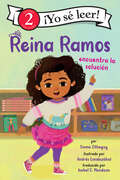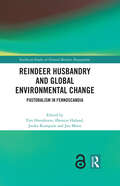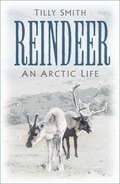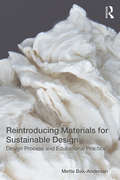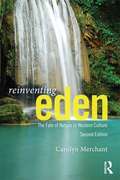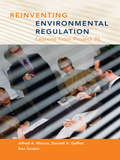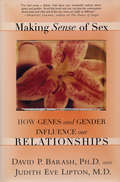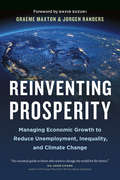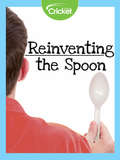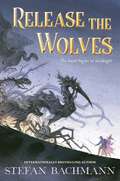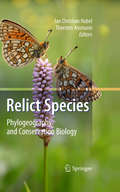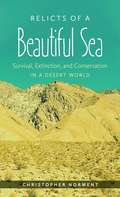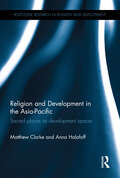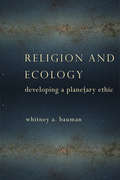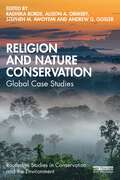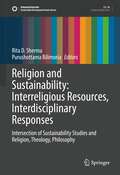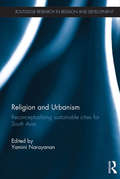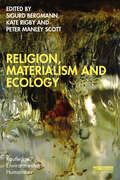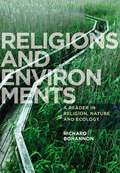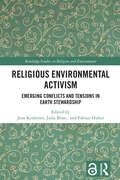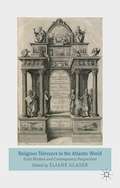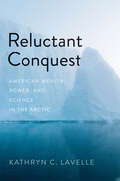- Table View
- List View
Reina Ramos encuentra la solución: Reina Ramos Works It Out (Spanish Edition) (I Can Read Level 2)
by Emma OtheguyThis popular Level Two beginning reader title about Reina Ramos dressing up for wax museum day at school is now available in Spanish translation. This Spanish-language book can be enjoyed by fluent Spanish speakers as well as those learning the language, whether at home or in a classroom.A Reina Ramos la emociona la idea de disfrazarse de Frida Kahlo para el museo de cera que se hará en su clase. Frida fue una persona de carácter firme, como la mamá y la abuela de Reina. Sin embargo, cuando Nora, su mejor amiga, también elige a Frida, Reina no sabe qué hacer. ¿De quién se irá a disfrazar ahora?Reina Ramos encuentra la solución es un libro ¡Yo sé leer! de nivel dos concebido para los niños que leen solos pero todavía necesitan un poco de ayuda. El libro incluye un glosario y una lista de personalidades famosas mencionadas en el cuento.
Reina de las Velas Negras
by P. J. DanielsSarah Chartimands es una capitana en un mundo mágico. Su barco: El Lady Flotsam. Su tripulación: piratas. Tras rescatar a un viejo amigo y mentor, Sarah se lanza a por el botín de su vida: el oro del Rey. Sin embargo, cuando no todo sale según lo previsto, se encuentra huyendo, superada en número y cuestionando su realidad; todo ello en una ciudad que intenta matarla. Esta aventura está cargada hasta los topes de pistolas, espadas y hechizos. ¿Podrá Sarah salvar un plan fallido? Y lo que es más importante, ¿encontrará la forma de salir viva?
Reindeer Husbandry and Global Environmental Change: Pastoralism in Fennoscandia (Earthscan Studies in Natural Resource Management)
by Tim HorstkotteThis volume offers a holistic understanding of the environmental and societal challenges that affect reindeer husbandry in Fennoscandia today. Reindeer husbandry is a livelihood with a long traditional heritage and cultural importance. Like many other pastoral societies, reindeer herders are confronted with significant challenges. Covering Norway, Sweden and Finland – three countries with many differences and similarities – this volume examines how reindeer husbandry is affected by and responds to global environmental change and resource extraction in boreal and arctic social-ecological systems. Beginning with an historical overview of reindeer husbandry, the volume analyses the realities of the present from different perspectives and disciplines. Genetics, behavioural ecology of reindeer, other forms of land use, pastoralists’ norms and knowledge, bio-economy and governance structures all set the stage for the complex internal and externally imposed dynamics within reindeer husbandry. In-depth analyses are devoted to particularly urgent challenges, such as land-use conflicts, climate change and predation, identified as having a high potential to shape the future pathways of the pastoral identity and productivity. These futures, with their risks and opportunities, are explored in the final section, offering a synthesis of the comparative approach between the three countries that runs as a recurring theme through the book. With its richness and depth, this volume contributes significantly to the understanding of the substantial impacts on pastoralist communities in northernmost Europe today, while highlighting viable pathways to maintaining reindeer husbandry for the future. This book will be of great interest to students and scholars of both the natural and social sciences who work on natural resource management, global environmental change, pastoralism, ecology, social-ecological systems, rangeland management and Indigenous studies.
Reindeer: An Arctic Life
by Tilly SmithIn this enchanting book, self-confessed reindeer geek Tilly Smith leads the reader through the extraordinary natural history of the reindeer with charming anecdotes about her own Scottish herd.From their flat ‘clown-like’ hooves to their warm furry noses and majestic antlers, fall in love with nature’s most adaptable arctic mammal.
Reintroducing Materials for Sustainable Design: Design Process and Educational Practice
by Mette Bak-AndersenReintroducing Materials for Sustainable Design provides instrumental theory and practical guidance to bring materials back into a central role in the design process and education. To create designs that are sustainable and respond to current environmental, economic and cultural concerns, practitioners and educators require a clear framework for materials use in design and product manufacturing. While much has been written about sustainable design over the last two decades, outlining systems of sustainability and product criteria, to design for material circularity requires a detailed understanding of the physical matter that constitutes products. Designers must not just know of materials but know how to manipulate them and work with them creatively. This book responds to the gap by offering a way to acquire the material knowledge necessary to design physical objects for sustainability. It reinforces the key role and responsibility of designers and encourages designers to take back control over the ideation and manufacturing process. Finally, it discusses the educational practice involved and the potential implications for design education following implementation, addressing didactics, facilities and expertise. This guide is a must-read for designers, educators and researchers engaged in sustainable product design and materials.
Reinventing Eden: The Fate of Nature in Western Culture
by Carolyn MerchantThis revised edition of Carolyn Merchant’s classic Reinventing Eden has been updated with a new foreword and afterword. Visionary quests to return to the Garden of Eden have shaped Western Culture. This book traces the idea of rebuilding the primeval garden from its origins to its latest incarnations and offers a bold new way to think about the earth.
Reinventing Environmental Regulation: Lessons from Project XL
by Alfred A. Marcus Donald A. Geffen Ken Professor SextonProject XL (eXcellence and Leadership) was the flagship effort by the Clinton administration for 'cleaner, cheaper, and smarter' regulation. Under Project XL, business promised better performance in exchange for a regulatory approach focused more on results than means, with the Environmental Protection Agency (EPA) measuring pollution reduction across rather than at individual sources within a facility. Reinventing Environmental Regulation is a compelling account of the breakdown in negotiations to implement Project XL at a tape manufacturing plant of 3M, a company widely recognized as environmentally progressive. Marcus, Geffen, and Sexton discuss the conflicting goals of participants, the influences of personality and organizational culture, and complications caused by changes in 3M‘s external business environment. They compare the 3M case with EPA negotiations involving Intel, Merck, and Weyerhaeuser, finding similarly contentious, though less fatal disagreements about the meaning of 'superior environmental performance.' In common with other recent proposals, Project XL emphasized cooperative, flexible regulatory approaches. Reinventing Environmental Regulation demonstrates the difficulty of putting these appealing ideas into practice, while offering encouragement for continued innovations.
Reinventing Nature?: Responses To Postmodern Deconstruction
by Gary Paul Nabhan Albert Borgmann Michael E. Soulé Kathryn Hayles Gary Lease Alan GussowHow much of science is culturally constructed? How much depends on language and metaphor? How do our ideas about nature connect with reality? Can nature be "reinvented" through theme parks and malls, or through restoration?Reinventing Nature? is an interdisciplinary investigation of how perceptions and conceptions of nature affect both the individual experience and society's management of nature. Leading thinkers from a variety of fields -- philosophy, psychology, sociology, public policy, forestry, and others -- address the conflict between perception and reality of nature, each from a different perspective. The editors of the volume provide an insightful introductory chapter that places the book in the context of contemporary debates and a concluding chapter that brings together themes and draws conclusions from the dialogue.In addition to the editors, contributors include Albert Borgmann, David Graber, N. Katherine Hayles, Stephen R. Kellert, Gary P. Nabhan, Paul Shepard, and Donald Worster.
Reinventing Prosperity: Managing Economic Growth to Reduce Unemployment, Inequality, and Climate Change
by Jorgen Randers Graeme Maxton&“An important contribution to the global debate about growth, equality, climate change, and the path to a viable human future.&” —David Korten, international bestselling author of When Corporations Rule the World The biggest challenges facing human wellbeing today—widening income inequality, continuing global poverty, and environmental degradation—may be simple to solve in theory. But, because we are required to come up with solutions that are acceptable to a political majority in the rich world, they are much harder to solve in practice. Most of the commonly proposed &“solutions&” are simply not acceptable to most people. Many of these proposed solutions—like stopping the use of fossil fuels—require a sacrifice today in order to obtain an uncertain advantage in the far future. Therefore they are politically infeasible in the modern world, which is marked by relatively short term thinking. In Reinventing Prosperity, Graeme Maxton and Jorgen Randers provide a new approach altogether through thirteen recommendations which are both politically acceptable and which can be implemented in the current period of slow economic growth around the world. Reinventing Prosperity solves the forty-year-old growth/no-growth standoff, by providing a solution to income inequality, continuing global poverty and climate change, a solution that will provide for economic growth but with a declining ecological footprint.Reinventing Prosperity shows us how to live better on our finite planet—and in ways we can agree on. &“An essential guide to those who want to change the world for the better—and for certain.&” —Ha-Joon Chang, international bestselling author of 23 Things They Don&’t Tell You About Capitalism &“[A] well-argued book . . . explaining complex issues in a style that is clear, logical, and succinct.&” —Publishers Weekly
Reinventing the Spoon
by Cricket MediaThe Bakeys company uses a simple recipe to make edible spoons in the hopes of cutting down on plastic trash.
Release the Wolves
by Stefan BachmannWhen a blacksmith’s apprentice witnesses a friend being killed by a legendary monster, he must decide between waiting for war in fear and silence, or risking everything to fight back. An extraordinary novel about friendship, tradition, obedience, and the monsters lurking behind every corner from internationally bestselling author Stefan Bachmann. For readers of Scary Stories for Young Foxes and Serafina and the Black Cloak.One thousand years ago, the Elduari conquered the country of Varen in a brutal war. Now, every few generations they subject their one-time enemies to a terrible tradition: bloodthirsty monsters are unleashed across the land, attacking indiscriminately, keeping the population in a perpetual dark age.For Argo, fear of another Release is something he has always lived with. When his friend is killed by a monster during a routine patrol, Argo suspects that another Release is coming, and sooner than everyone expects. But in a country built on fear, getting answers is dangerous. Elduari spies are hiding behind the most familiar faces, and any hint of disobedience could lead to the death of thousands.As whispers of dissent circulate, rebellion grows in the villages. Now Argo and his new ally, Ana—the King’s eldest daughter who is also a monster hunter in disguise—must decide whether or not to join the fight. But what if it’s already too late?From Stefan Bachmann, the internationally renowned author of The Peculiar and Cinders & Sparrows, Release the Wolves is an atmospheric, suspenseful, and haunting novel about friendship, family, power, and the monsters all around us.
Relict Species
by Jan Christian Habel Thorsten AssmannThis book provides an overview of the importance of research on relict species and presents conclusions and findings on the conservation of these species. There are relict species and populations from nearly all plant and animal groups and they contribute substantially to biodiversity across the globe. Current diversity patterns are influenced by both historic and recent ecological conditions. Relict species are of particular importance, as they usually suffer more severely from human activities than do non-relict populations; the situation is also potentially critical, as many relict species and populations have the potential to colonize large areas when the climate changes. The more than 27 contributions in this book highlight the history and status of today's relict species and populations and apply molecular genetics, morphometry, modelling and conservation biology to describe the past and present situations and to predict future trends of relict species' distribution.
Relicts of a Beautiful Sea
by Christopher NormentAlong a tiny spring in a narrow canyon near Death Valley, seemingly against all odds, an Inyo Mountain slender salamander makes its home. "The desert," writes conservation biologist Christopher Norment, "is defined by the absence of water, and yet in the desert there is water enough, if you live properly." Relicts of a Beautiful Sea explores the existence of rare, unexpected, and sublime desert creatures such as the black toad and four pupfishes unique to the desert West. All are anomalies: amphibians and fish, dependent upon aquatic habitats, yet living in one of the driest places on earth, where precipitation averages less than four inches per year. In this climate of extremes, beset by conflicts over water rights, each species illustrates the work of natural selection and the importance of conservation. This is also a story of persistence--for as much as ten million years--amid the changing landscape of western North America. By telling the story of these creatures, Norment illustrates the beauty of evolution and explores ethical and practical issues of conservation: what is a four-inch-long salamander worth, hidden away in the heat-blasted canyons of the Inyo Mountains, and what would the cost of its extinction be? What is any lonely and besieged species worth, and why should we care?
Religion and Development in the Asia-Pacific: Sacred places as development spaces (Routledge Research in Religion and Development)
by Matthew Clarke Anna HalafoffCommunity development is most effective and efficient when it is situated and led at the local level and considers the social behaviours, needs and worldviews of local communities. With more than eight out of ten people globally self-reporting religious belief, Religion and Development in the Asia-Pacific: Sacred places as development spaces argues that the role and impact of religions on community development needs to be better understood. It also calls for greater attention to be given to the role of sacred places as sites for development activities, and for a deeper appreciation of the way in which sacred stories and teachings inspire people to work for the benefit of others in particular locations. The book considers theories of ‘place’ as a component of successful development interventions and expands this analysis to consider the specific role that sacred places – buildings and social networks – have in planning, implementing and promoting sustainable development. A series of case studies examine various sacred places as sites for development activities. These case studies include Christian churches and disaster relief in Vanuatu; Muslim shrines and welfare provision in Pakistan; a women’s Buddhist monastery in Thailand advancing gender equity; a Jewish aid organisation providing language training to Muslim Women in Australia; and Hawaiian sacred sites located within a holistic retreat centre committed to ecological sustainability. Religion and Development in the Asia-Pacific demonstrates the important role that sacred spaces can play in development interventions, covering diverse major world religions, interfaith and spiritual contexts, and as such will be of considerable interest for postgraduate students and researchers in development studies, religious studies, sociology of religion and geography.
Religion and Ecology: Developing a Planetary Ethic
by Whitney BaumanMoving beyond identity politics while continuing to respect diverse entities and concerns, Whitney A. Bauman builds a planetary politics that better responds to the realities of a pluralistic world. Calling attention to the historical, political, and ecological influences shaping our understanding of nature, religion, humanity, and identity, Bauman collapses the boundaries separating male from female, biology from machine, human from more than human, and religion from science, encouraging readers to embrace hybridity and the inherent fluctuations of an open, evolving global community.As he outlines his planetary ethic, Bauman concurrently develops an environmental ethic of movement that relies not on place but on the daily connections we make across the planet. He shows how both identity politics and environmental ethics fail to realize planetary politics and action, limited as they are by foundational modes of thought that create entire worlds out of their own logic. Introducing a postfoundational vision not rooted in the formal principles of "nature" or "God" and not based in the idea of human exceptionalism, Bauman draws on cutting-edge insights from queer, poststructural, and deconstructive theory and makes a major contribution to the study of religion, science, politics, and ecology.
Religion and Nature Conservation: Global Case Studies (Routledge Studies in Conservation and the Environment)
by Radhika Borde Alison A Ormsby Stephen M Awoyemi Andrew G GoslerThis book presents a broad array of global case studies exploring the interaction between religion and the conservation of nature, from the viewpoints of the religious practitioners themselves. With conservation and religion often being championed as allies in the quest for a sustainable world where humans and nature flourish, this book provides a much-needed compendium of detailed examples where religion and conservation science have been brought together. Case studies cover a variety of religions, faiths and practices, including traditional, Indigenous, Buddhism, Christianity, Hinduism, Islam, Jainism, Judaism, Shinto and Zoroastrianism. Importantly, this volume gives voice to the religious practitioners and adherents themselves. Beyond an exercise in anthropology, ethnobiology and comparative religion, the book is an applied work, seeking the answer to how in a world of nearly eight billion people, we might help our own species to prevent the extinction of life. This book will be of great interest to students and scholars of nature conservation, environment and religion, cultural geography and ethnobiology, as well as practitioners and professionals working in conservation.
Religion and Sustainability: Intersection of Sustainability Studies and Religion, Theology, Philosophy (Sustainable Development Goals Series)
by Purushottama Bilimoria Rita D. ShermaThis volume brings sustainability studies into creative and constructive conversation with actions, practices, and worldviews from religion and theology supportive of the vision and work of the UN SDGs. It features more than 30 chapters from scholars across diverse disciplines, including economics, ethics, theology, sociology, ritual studies, and visual culture. This interdisciplinary content presents new insights for inhibiting ecospheric devastation, which is inextricably linked to unsustainable financial, societal, racial, geopolitical, and cultural relationships. The chapters show how humanistic elements can enable the establishment of sustainable ways of thinking, feeling, and acting. This includes the aesthetic and emotive dimensions of life. The contributors cover such topics as empowering women and girls to systemically reverse climate change; nurturing interreligious peace; decolonizing landscapes; and promoting horticulture, ecovillages, equity, and animal ethics. Coverage integrates a variety of religious and theological perspectives. These include Buddhism, Judaism, Hinduism, Islam, Christianity, and other traditions.To enable the restoration and flourishing of the ecosystems of the biosphere, human societies need to be reimagined and reordered in terms of economic, cultural, religious, racial, and social equitability. This volume illustrates transformative paradigms to help foster such change. It introduces new principles, practices, ethics, and insights to the discourse. This work will appeal to students, scholars, and professionals researching the ethical, moral, social, cultural, psychological, developmental, and other social scientific impacts of religion on the key markers of sustainability.
Religion and Urbanism: Reconceptualising sustainable cities for South Asia (Routledge Research in Religion and Development)
by Yamini NarayananConceptions of 'sustainable cities' in the pluralistic and multireligious urban settlements of developing nations need to develop out of local cultural, religious and historical contexts to be inclusive and accurately respond to the needs of the poor, ethnic and religious minorities, and women. Religion and Urbanism contributes to an expanded understanding of 'sustainable cities' in South Asia by demonstrating the multiple, and often conflicting ways in which religion enables or challenges socially equitable and ecologically sustainable urbanisation in the region. In particular, this collection focuses on two aspects that must inform the sustainable cities discourse in South Asia: the intersections of religion and urban heritage, and religion and various aspects of informality. This book makes a much-needed contribution to the nexus between religion and urban planning for researchers, postgraduate students and policy makers in Sustainable Development, Development Studies, Urban Studies, Religious Studies, Asian Studies, Heritage Studies and Urban and Religious Geography.
Religion, Heritage and the Sustainable City: Hinduism and urbanisation in Jaipur (Routledge Research in Religion and Development)
by Yamini NarayananThe speed and scale of urbanisation in India is unprecedented almost anywhere in the world and has tremendous global implications. The religious influence on the urban experience has resonances for all aspects of urban sustainability in India and yet it remains a blind spot while articulating sustainable urban policy. This book explores the historical and on-going influence of religion on urban planning, design, space utilisation, urban identities and communities. It argues that the conceptual and empirical approaches to planning sustainable cities in India need to be developed out of analytical concepts that define local sense of place and identity. Examining how Hindu religious heritage, beliefs and religiously influenced planning practices have impacted on sustainable urbanisation development in Jaipur and Indian cities in general, the book identifies the challenges and opportunities that ritualistic and belief resources pose for sustainability. It focuses on three key aspects: spatial segregation and ghettoisation; gender-inclusive urban development; and the nexus between religion, nature and urban development. This cutting-edge book is one of the first case studies linking Hindu religion, heritage, urban development, women and the environment in a way that responds to the realities of Indian cities. It opens up discussion on the nexus of religion and development, drawing out insightful policy implications for the sustainable urban planning of many cities in India and elsewhere in South Asia and the developing world.
Religion, Materialism and Ecology (Routledge Environmental Humanities)
by Sigurd Bergmann, Kate Rigby and Peter Manley ScottThis timely collection of essays by leading international scholars across religious studies and the environmental humanities advances a lively discussion on materialism in its many forms. While there is little agreement on what ‘materialism’ means, it is evident that there is a resurgence in thinking about matter in more animated and active ways. The volume explores how debates concerning the new materialisms impinge on religious traditions and the extent to which religions, with their material culture and beliefs in the Divine within the material, can make a creative contribution to debates about ecological materialisms. Spanning a broad range of themes, including politics, architecture, hermeneutics, literature and religion, the book brings together a series of discussions on materialism in the context of diverse methodologies and approaches. The volume investigates a range of issues including space and place, hierarchy and relationality, the relationship between nature and society, human and other agencies, and worldviews and cultural values. Drawing on literary and critical theory, and queer, philosophical, theological and social theoretical approaches, this ground-breaking book will make an important contribution to the environmental humanities. It will be a key read for postgraduate students, researchers and scholars in religious studies, cultural anthropology, literary studies, philosophy and environmental studies.
Religions and Environments: A Reader in Religion, Nature and Ecology
by Richard BohannonRecent decades have witnessed a surge of literature and activism from religious leaders and thinkers on the natural environment. This volume brings together some of the most thought-provoking examples of such writings from the nineteenth century up to today, spanning a variety of methodological approaches and religious traditions, viewpoints, and locations. Within three parts--the wilderness, the garden, and the city--are essays representing nature spiritualities, Asian traditions, Judaism, Islam, Christianity, and indigenous traditions. Each part contains a critical introduction by the editor which provides an overview of issues and guides students to key ideas. Ideal resource for courses on religion and the environment, religion and ecology, and religion and nature.
Religious Environmental Activism: Emerging Conflicts and Tensions in Earth Stewardship (Routledge Studies in Religion and Environment)
by Jens Koehrsen Julia Blanc Fabian HuberThis volume explores how religious and spiritual actors engage for environmental protection and fight against climate change. Climate change and sustainability are increasingly prominent topics among religious and spiritual groups. Different faith traditions have developed "green" theologies, launched environmental protection projects and issued public statements on climate change. Against this background, academic scholarship has raised optimistic claims about the strong potentials of religions to address environmental challenges. Taking a critical stance with regard to these claims, the chapters in this volume show that religious environmentalism is an embattled terrain. Tensions are an inherent part of religious environmentalism. These do not necessarily manifest themselves in open clashes between different parties but in different actions, views, theologies, ambivalences, misunderstandings, and sometimes mistrust. Keeping below the surface, these tensions can create effective barriers for religious environmentalism. The chapters examine how tensions are manifested and dealt with through a range of empirical case studies in various world regions. Covering different religious and spiritual traditions, they reflect on intradenominational, interdenominational, interreligious, and religious-societal tensions. Thereby, this volume sheds new light on the problems that religions face when they seek to take an active role in today’s societal challenges.
Religious Tolerance in the Atlantic World
by Eliane GlaserPlacing topical debates in historical perspective, the essays by leading scholars of history, literature and political science explore issues of difference and diversity, inclusion and exclusion, and faith in relation to a variety of Christian groups, Jews and Muslims in the context of both early modern and contemporary England and America.
Religious Tourism and the Environment (CABI Religious Tourism and Pilgrimage Series)
by Kiran A. Shinde and Daniel H. OlsenThe remarkable growth in religious tourism across the world has generated considerable interest in the impacts of this type of tourism. Focusing here on environmental issues, this book moves beyond the documentation of environmental impacts to examine in greater depth the intersections between religious tourism and the environment. Beginning with an in-depth introduction that highlights the intersections between religion, tourism, and the environment, the book then focuses on the environment as a resource or generator for religious tourism and as a recipient of the impacts of religious tourism. Chapters included discuss such important areas as theological views, environmental responsibility, and host perspectives. Covering as many cultural and environmental regions as possible, this book provides: -An in-depth yet holistic view of the relationships between religious tourism and the environment; -A conceptual framework that goes beyond listing potential environment impacts; -A strong focus on explaining the universality of the deeper environmental issues surrounding sacredness and sacred places; -A discussion of the role of disease and health-related issues at mass religious gatherings. From a global writing team and featuring case studies spanning Europe and Asia, this book will be of great interest to researchers and students of tourism and religious studies, as well as those studying environmental issues.
Reluctant Conquest: American Wealth, Power, and Science in the Arctic
by Kathryn C. LavelleA comprehensive history of U.S. involvement in the Arctic, from the American Revolution through the acquisition of Alaska to the present day What drives American foreign relations in the Arctic? It is difficult to give a unified answer to this question because most histories of the region are divided between the Atlantic and Pacific coasts, Asian and European strategic interests, or federal government and Indigenous peoples&’ concerns, making it difficult to understand the connections among the environmental challenges, scientific understandings, strategic calculations, and governance relationships. Most Americans do not think of their country as an Arctic power, yet it is a region where the United States has had important ties throughout its history. In this sweeping study, from the founding of the country through the acquisition of Alaska to the present, Kathryn C. Lavelle considers American relations across the circumpolar North, incorporating discussions of economics, national security, and science that are conventionally separated. Lavelle argues that it is impossible to understand U.S. policy without a knowledge of American political development and of how scientific understandings have grown alongside studies of climate and other environmental issues. This history has important implications for future American policy regarding traditional national security and political economy, in addition to climate change and environmental cooperation.
